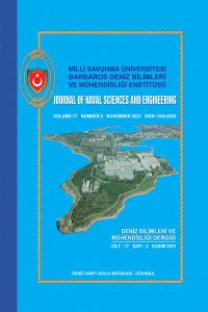BATHYMETRIC ANALYSIS OF LYSTAD BAY, HORSESHOE ISLAND BY USING HIGH RESOLUTION MULTIBEAM ECHOSOUNDER DATA
BATHYMETRIC ANALYSIS OF LYSTAD BAY, HORSESHOE ISLAND BY USING HIGH RESOLUTION MULTIBEAM ECHOSOUNDER DATA
Horseshoe Island, Lystad Bay, Multibeam Echosounder Data, Bathymetry.,
___
- Alkan, R.M., Kalkan, Y., Aykut, N.O. (2006). “Sound velocity determination with empirical formulas and bar check”. Proceedings of 23rd FIG Congress, Oct. 8-13, Munich, Germany, pp: 1-14
- Bart, P.J., Mullally, D., Golledge, N.R. (2016). “The influence of continental shelf bathymetry on Antarctic Ice Sheet response to climate forcing”. Global and Planetary Change, Vol. 142, pp. 87-95.
- Bentley, M. J., Johnson, J. S., Hodgson, D. A., Dunai, T., Freeman, S.P.H.T., Cofaigh, O. C. (2019). “Rapid Deglaciation of Marguerite Bay, Western Antarctic Peninsula in the Early Holocene”. Quaternary Science Reviews, Vol. 30, Issues 23-24, pp. 3338-3349.
- Brissette, M. B., Clarke, J. E. (2015). “Side Scan Versus Multibeam Echosounder Object Detection: A Comparative Analysis”. The International Hydrographic Review, Vol. 76(2).
- British Admiralty Nautical Chart of BA2974. (2012) Adelaide Island to Neny Fjord[map]. 1:150000. British Government Surveys.
- British Admiralty Nautical Chart of BA3213. (1960). Lystad Bay[map]. 1:50000. British Government Surveys.
- Çiner, A., Yıldırım, C., Sarıkaya, M. A., Seong, Y. B., Byung, Y. Y. (2019). “Cosmogenic 10 be exposure dating of glacial erratics on Horseshoe Island in western Antarctic Peninsula confirms rapid deglaciation in the Early Holocene”. Antarctic Science, Vol. 31, Issue 6, pp. 319-331.
- Fofonoff, Nicholas P., Millard, Robert C. (1983). “Algorithms for computation of fundamental properties of seawater”. UNESCO Technical Papers in Marine Science No. 44.
- Hughes Clarke, J.E. (2018). “Multibeam Echosounders”. Chapter 3, Submarine geomorphology. Springer International Publishing, New York, pp. 25–42
- International Hydrographic Organization (IHO) Publication No.44 6th Edition. (2020). “IHO Standards for Hydrographic Surveys”. Monaco, Published by the IHO.
- International Hydrographic Organization (IHO) Publication No.32. (2019). “Hydrographic Dictionary / Multilingual Reference for IHO Publications”).
- International Hydrographic Organization (IHO) Publication No.M-13 1st Edition. (2005). “Manual on Hydrography”. Monaco, Published by the IHO.
- Jung, J., Ko, Y., Lee, J., Yang, K., Park, Y.K., Kim, S., Moon, H., Kim, H.J., Yoo, K.C. (2021). “Multibeam Bathymetry and Distribution of Clay Minerals on Surface Sediments of a Small Bay in Terra Nova Bay, Antarctica”. Minerals, Vol. 11, Issue 72, pp. 1-12.
- Kenny, A.J., Cato, I., Desprez, M., Fader, G., Schüttenhelm, R.T.E., Side, J. (2003). “An overview of seabed-mapping technologies in the context of marine habitat classification”. ICES Journal of Marine Science, Vol. 60, Issue 2, pp. 411-418.
- L-3 Communications SeaBeam Instruments. (2000). “Multibeam sonar theory of operation”. https://www3.mbari.org/data/mbsystem/sonarfunction/ SeaBeamMultibeamTheoryOperation.pdf Accessed 06 January 2022.
- Parnum, I., Siwabessy, J., Gavrilov, A., Parsas, M. (2009). “A comparison of Single Bram and Multibeam Sonar Systems in Seafloor Habitat Mapping”. 3rd International Conference & Exibition on Underwater Acoustics Measurements: Technologies & Results”. pp. 155-162.
- Quantarctica 3.2 GIS software. (2021). Norwegian Polar Institute, https://www.npolar.no/quantarctica/ Accessed 13 February 2022.
- Salon, S., Crise, A., Picco, P., Marinis, E., Gasparini, O. (2003). “Sound speed in the Mediterranean Sea: an analysis from a climatological data set”. Annales Geophysicae, Vol.21, pp.833-846.
- Spellman, F.R. (2021). “Understanding Climate Change: A Practical Guide”. Chapter 7, Glaciers. BernanPress, Maryland, pp. 95–100.
- Yıldırım, C. (2019). “Geomorphology of Horseshoe Island, Marguerite Bay, Antarctica”. Journal of Maps, Vol. 16, Issue 2, pp. 56-67.
- Zhao, D.N., Wu, Z.Y., Zhou, J.Q. (2015). “A new method of automatic SVP optimization based on MOV algorithm”. Marine Geodesy, Vol.38 Issue 3, pp.225–240.
- ISSN: 1304-2025
- Yayın Aralığı: 2
- Başlangıç: 2003
- Yayıncı: Milli Savunma Üniversitesi Deniz Harp Okulu Dekanlığı
Emre TÜKENMEZ, Emre GÜLHER, Özgür KAYA, H. Fatih POLAT
MECHANICAL GYROSCOPE-BASED ROLL MOTION REDUCTION OF MARINE VEHICLES: AN EDUCATIONAL SETUP
CPM VE PERT YÖNTEMLERİYLE PROJE PLANLAMA: SAVUNMA SANAYİ ÖRNEĞİ
AKIŞ DÜZENLEYİCİLERİN BİR JENERİK DENİZALTI YELKENİ ETRAFINDAKİ AKIŞA ETKİSİNİN İNCELENMESİ
Gökay SEVGİ, Barış BARLAS, Oral ÜNAL
THE EFFECT OF FOV ANGLE ON A RSSI-BASED VISIBLE LIGHT POSITIONING SYSTEM
A NEW RECEIVER DESIGN FOR SPATIAL MODULATION SYSTEMS
